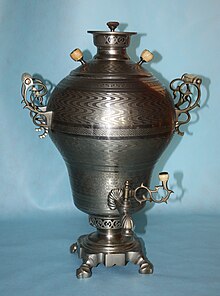Samovar
A samovar ( Russian самовар [ səmɐ'var ] ; само samo "self", вар was "cooking"; literally "self-catering", Persian سماور) is an originally Russian tea machine , kettle or hot water heater . Samovars are available in a wide variety of sizes, from the well-known, often artfully decorated table-top devices from around one liter capacity, which are used exclusively for tea preparation, to boiler-like units for general hot water preparation in the kitchen or for supplying passengers to a railroad car (e.g. 1, 5 ' Wedro ' ("bucket") of 12.7 liters each = about 20 liters) up to kettles with a capacity of up to 40 Wedro (over half a cubic meter), which could cover the entire hot water and partly also heat requirements of a large household .
History and dissemination
The samovar was first mentioned in writing in the 1730s.
This type of tea-making is particularly widespread in Russia , Belarus , Ukraine , Turkey , Iran and Central Asia in general .
The city of Tula is a center of Russian samovar production . If you do something superfluous, you don't carry owls to Athens in Russia , but drive your own samovar to Tula .
Since 2007 in Gorodets in Grishaev house a museum named "House of the Russian samovars" which shows an extensive collection of historical samovars.
- Historic samovars on Soviet postage stamps (1989)
How it works and how to prepare tea
Originally a samovar was heated with charcoal or kerosene . As is customary with today's kettles, modern models work with electrical heating elements . The largest part of a samovar is the metal, mostly copper kettle, on the lower side edge of which there is a drain tap through which the hot water, e.g. for making tea or mors from Warenje , is taken.
The fuel-heated samovars have a tube inside the kettle in which the combustion takes place. The combustion air is supplied through a perforated screen under the boiler. The heat is transferred to the water surrounding the pipe via the pipe wall. At the same time, the vertical pipe ensures the chimney effect required for good combustion . The upper end of the tube pierces the lid of the kettle centrally from below. To heat up the samovar, an extension is attached to the upper end of the pipe in order to increase the chimney effect. When the water has finished boiling, the pipe extension is replaced by the "comfort"; This is an attachment that has small openings on its side from which the still hot combustion air (above the boiler lid) can escape.
Samovars are usually filled with water at the top through an opening that is closed with a lid. In this cover there are again openings through which the pressure in the boiler when the water is heated can escape in the form of hot steam.
If the samovar is used to prepare tea, a small separate jug (Russian: Tschainik чайник = tea kettle) is placed on the lid, in which a tea concentrate is then made with a large amount of tea leaves (usually black tea ) and a little water - the so-called Zavarka - is scheduled. This concentrate can be kept warm and used for hours. The drinkable tea can only be obtained by diluting a small amount of tea concentrate with the boiling water from the samovar, in a ratio of about 1: 3 to 1:10. This procedure has two advantages: On the one hand, everyone can mix the tea in the desired concentration, and on the other hand, it prevents deposits from forming in the samovar's kettle (which is often difficult to clean).
The tea is drunk from both cups and glasses. A hot tea glass is often placed in a metal holder with a handle, the podstakannik , and can thus be safely held in the hand or placed on the table in a moving train.
Web links
- Russian Tea HOWTO ( Memento of March 7, 2012 in the Internet Archive ) (English)
- "In the realm of samovars" , Voice of Russia , May 31, 2011 (German)
Individual evidence
- ↑ Norbert P. Franz (Ed.): Lexicon of Russian Culture . Darmstadt: Wissenschaftliche Buchgesellschaft, 2002. S. 390.
- ↑ Andrey Gundarev: House of Samovars: Look into the history of Russia. (No longer available online.) March 16, 2017, archived from the original on March 15, 2017 ; accessed on March 16, 2017 . Info: The archive link was inserted automatically and has not yet been checked. Please check the original and archive link according to the instructions and then remove this notice.
- ↑ Curt Maronde: All about tea . Frankfurt a. M .: Fischer Taschenbuch Verlag, 1973. P. 33ff.





